Toyota Camry (XV70): Installing the spare tire
1. Remove any dirt or foreign matter from the wheel contact surface.
If foreign matter is on the wheel contact surface, the wheel nuts may loosen while the vehicle is in motion, causing the tire to come off.
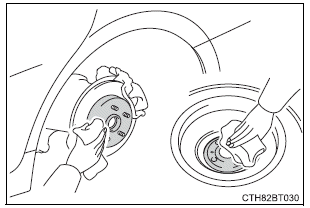
2. Install the tire and loosely tighten each wheel nut by hand by approximately the same amount.
When replacing a steel wheel with a steel wheel, tighten the wheel nuts until the tapered portion comes into loose contact with the disc wheel seat.
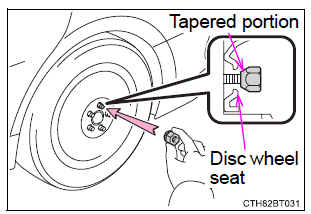
When replacing an aluminum wheel with a steel wheel, tighten the wheel nuts until the tapered portion comes into loose contact with the disc wheel seat.
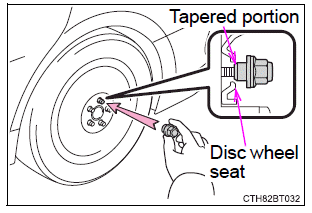
3. Lower the vehicle.
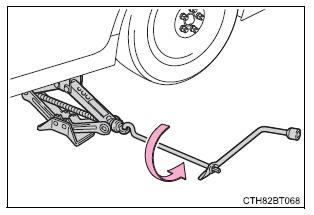
4. Firmly tighten each wheel nut two or three times in the order shown in the illustration.
Vehicles with wheel locks: Tighten the wheel lock using the wheel lock key after tightening the other wheel nuts.
Tightening torque: 76 ft-lbf (103 N-m, 10.5 kgf-m)
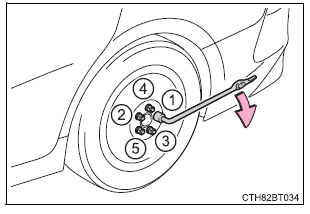
5. Stow the flat tire, tire jack and all tools.
■The compact spare tire
- The compact spare tire is identified by the label "TEMPORARY USE
ONLY" on the tire sidewall.
Use the compact spare tire temporarily, and only in an emergency.
- Make sure to check the tire inflation pressure of the compact spare tire.
■When using the compact spare tire
As the compact spare tire is not equipped with a tire pressure warning valve and transmitter, low inflation pressure of the spare tire will not be indicated by the tire pressure warning system. Also, if you replace the compact spare tire after the tire pressure warning light comes on, the light remains on.
■When the compact spare tire is equipped
When driving with the compact spare tire installed, the vehicle height will be different than when driving with standard tires.
■If you have a flat front tire on a road covered with snow or ice (vehicles with 16 or 17-inch wheels)
Install the compact spare tire on one of the rear wheels of the vehicle.
Perform the following steps and fit tire chains to the front tires:
1. Replace a rear tire with the compact spare tire.
2. Replace the flat front tire with the tire removed from the rear of the vehicle.
3. Fit tire chains to the front tires.
WARNING
■When using the compact spare tire
- Remember that the compact spare tire provided is specifically designed for use with your vehicle. Do not use your compact spare tire on another vehicle.
- Do not use more than one compact spare tires simultaneously.
- Replace the compact spare tire with a standard tire as soon as possible.
- Avoid sudden acceleration, abrupt steering, sudden braking and shifting operations that cause sudden engine braking.
■When the compact spare tire is attached
The vehicle speed may not be correctly detected, and the following systems may not operate correctly:
- ABS & Brake assist
- VSC
- TRAC
- EPS
- AHB (Automatic High Beam)
- Dynamic radar cruise control*
- Dynamic radar cruise control with full-speed range*
- LTA (Lane Tracing Assist)
- PCS (Pre-Collision System)
- Tire pressure warning system
- BSM (Blind Spot Monitor)*
- Intuitive parking assist*
- PKSB (Parking Support Brake)*
- Rear view monitor system*
- Toyota parking assist monitor*
- Panoramic view monitor*
- Navigation system*
Also, not only can the following systems not be utilized fully, but they may actually negatively affect the drive-train components:
- Dynamic Torque Control AWD system*
*: If equipped
■Speed limit when using the compact spare tire
Do not drive at speeds in excess of 50 mph (80 km/h) when a compact spare tire is installed on the vehicle.
The compact spare tire is not designed for driving at high speeds. Failure to observe this precaution may lead to an accident causing death or serious injury.
■After using the tools and jack
Before driving, make sure all the tools and jack are securely in place in their storage location to reduce the possibility of personal injury during a collision or sudden braking.
NOTICE
■Be careful when driving over bumps with the compact spare tire installed on the vehicle.
The vehicle becomes lower when driving with the compact spare tire compared to when driving with standard tires. Be careful when driving over uneven road surfaces.
■Driving with tire chains and the compact spare tire
Do not fit tire chains to the compact spare tire.
Tire chains may damage the vehicle body and adversely affect driving performance.
■When replacing the tires
When removing or fitting the wheels, tires or the tire pressure warning valve and transmitter, contact your Toyota dealer as the tire pressure warning valve and transmitter may be damaged if not handled correctly.
■To avoid damage to the tire pressure warning valve and transmitters
When a tire is repaired with liquid sealants, the tire pressure warning valve and transmitter may not operate properly. If a liquid sealant is used, contact your Toyota dealer or other qualified service shop as soon as possible. Make sure to replace the tire pressure warning valve and transmitter when replacing the tire.

